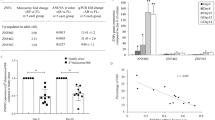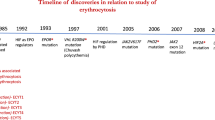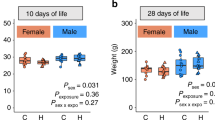Abstract
In infants and children, elevated whole blood zinc protoporphyrin/heme (ZnPP/H) measures iron-deficient (ID) erythropoiesis. Because immature erythrocytes are less dense than mature erythrocytes, we hypothesized that the sensitivity of ZnPP/H is improved if measured in the least dense cells. Blood was collected from control suckling, mildly and severely ID suckling rats. Cord blood was collected after uncomplicated pregnancies (control), diabetic pregnancies (severe ID) and after pregnancies at-risk for iron deficiency (mild ID). ZnPP/H was measured before and after a two-step density centrifugation to obtain the lightest 6.25% of erythrocyte (top fraction). The difference between whole blood and top fraction was defined as ΔZnPP/H. In rats, although the whole or top ZnPP/H differed by postnatal age, ΔZnPP/H was greatest after the interval with least body iron accrual. In either rats or humans with mild ID, whole blood ZnPP/H was similar to, but ΔZnPP/H was greater than controls. In rats and newborn humans, ΔZnPP/H is more sensitive than whole blood ZnPP/H in identifying conditions associated with impaired erythrocyte iron delivery and may become a useful tool in measuring erythrocyte iron incorporation in early development.
Similar content being viewed by others
Log in or create a free account to read this content
Gain free access to this article, as well as selected content from this journal and more on nature.com
or
Abbreviations
- IDM:
-
offspring of diabetes
- mild ID:
-
mild iron deficiency
- mild ID+Fe:
-
mild ID with oral iron
- severe ID:
-
severe iron deficiency anemia
- ZnPP/H:
-
zinc protoporphyrin/heme
References
Meyer MP, Haworth C, Meyer JH, Commerford A 1996 A comparison of oral and intravenous iron supplementation in preterm infants receiving recombinant erythropoietin. J Pediatr 129: 258–263
Brown MS 1996 Effect of transfusion and phlebotomy on serum ferritin levels in low birth weight infants. J Perinatol 16: 39–42
Winzerling JJ, Kling PJ 2001 Iron deficient erythropoiesis in premature infants measured by blood zinc protoporphyrin/heme. J Pediatr 139: 134–136
Juul SE, Zerzan JC, Strandjord TP, Woodrum DE 2003 Zinc protoporphyrin/heme as an indicator of iron status in NICU patients. J Pediatr 142: 273–278
Labbé RF, Finch CA, Smith NJ, Doan RN, Sood SK, Madan N 1979 Erythrocyte protoporphyrin/heme ratio in the assessment of iron status. Clin Chem 25: 87–92
Hastka J, Lasserre J-J, Schwarzbeck A, Hehlmann R 1994 Central role of zinc protoporphyrin in staging iron deficiency. Clin Chem 40: 768–773
Rettmer RL, Carlson TH, Origenes ML, Jack RM, Labb RF 1999 Zinc protoporphyrin/heme ratio for diagnosis of preanemic iron deficiency. Pediatrics 104: e37
Lott DG, Zimmerman MB, Labbé RF, Kling PJ, Widness JA 2005 Erythrocyte zinc protoporphyrin is elevated with prematurity and fetal hypoxemia. Pediatrics 116: 414–422
Miller SM, McPherson RJ, Juul SE 2006 Iron sulfate supplementation decreases zinc protoporphyrin to heme ratio in premature infants. J Pediatr 148: 44–48
Kling PJ 2006 Zinc protoporphyrin/heme ratio in premature infants: has it found its place?. J Pediatr 148: 8–10
Brugnara C, Chambers LA, Malynn E, Goldberg MA, Kruskall M 1993 Red blood cell regeneration induced by subcutaneous recombinant erythropoietin: iron-deficient erythropoiesis in iron-replete subjects. Blood 81: 956–964
Brugnara C, Hipp MJ, Irving PJ, Lathrop H, Lee PA, Minchello EM, Winkelman J 1994 Automated reticulocyte counting and measurement of reticulocyte cellular indices. Evaluation of the Miles H*3 blood analyzer. Am J Clin Pathol 102: 623–632
Brugnara C, Zurakowski D, DiCanzio J, Boyd T, Platt O 1999 Reticulocyte hemoglobin content to diagnose iron deficiency in children. JAMA 281: 2225–2230
Ullrich C, Wu A, Armsby C, Rieber S, Wingerter S, Brugnara C, Shapiro D, Bernstein H 2005 Screening healthy infants for iron deficiency using reticulocyte hemoglobin content. JAMA 294: 924–930
Bechensteen AG, Haga P, Halvorsen S, Liestol K, Lindemann R, Whitelaw A, Tollofsrud PA, Daae L, Thorstensen K, Sundal E 1997 Effect of low and moderate doses of recombinant human erythropoietin on the haematological response in premature infants on a high protein and iron intake. Eur J Pediatr 156: 56–61
Rushing D, Vengelen-Tyler V 1987 Evaluation and comparison of four reticulocyte enrichment procedures. Transfusion 27: 86–89
Dubuque SH, Dvorak B, Woodward SS, McCuskey RS, Kling PJ 2002 Iron deficient erythropoiesis in neonatal rats. Biol Neonate 81: 51–57
Dvorak B, McWilliam DL, Williams CS, Dominguez JA, Machen NW, McCuskey RS, Philipps AF 2000 Artificial formula induces precocious maturation of the small intestine of artificially reared suckling rats. J Pediatr Gastroenterol Nutr 31: 162–169
Hastka J, Lasserre JJ, Schwarzbeck A, Strauch M, Hehlmann R 1992 Washing erythrocytes to remove interferents in measurements of zinc protoporphyrin by front-face hematofluorometry. Clin Chem 38: 2184–2189
Constandoulakis M, Kay HE 1959 Observations on the centrifugal segregation of young erythrocytes. J Clin Pathol 12: 312–318
NCCLS 1996 Erythrocyte Protoporphyrin Testing: Approved Guideline (NCCLS Document C42-A). National Committee on Clinical Laboratory Standards, Villanova, PA pp 1–40
Aviv Biomedical 1993 Instruction Manual ZP Hematofluorometer Model 206D. Aviv Biomedical, Lakewood NJ pp 1–28
Lesser KB, Schoel SB, Widness JA, Kling PJ 2006 Elevated zinc protoporphyrin/heme ratios in umbilical cord blood after diabetic pregnancies. J Perinatol 26: 671–676
Pearson HA 1967 Life-span of the fetal red blood cell. J Pediatr 70: 166–171
Renton PH, Hancock JA 1964 A simple method of separating erythrocytes of different ages. Vox Sang 9: 183–186
Koepke JF, Koepke JA 1986 Reticulocytes. Clin Lab Haematol 8: 169–179
Petry CD, Eaton ME, Wobken JD, Mills MM, Johnson DE, Georgieff MK 1992 Iron deficiency of liver, heart, and brain in newborn infants of diabetic mothers. J Pediatr 121: 109–114
Georgieff MK, Landon MB, Mills MM, Hedlund BE, Faassen AE, Schmidt RL, Ophoven JJ, Widness JA 1990 Abnormal iron distribution in infants of diabetic mothers: spectrum and maternal antecedents. J Pediatr 117: 455–461
Kivivuori SM, Heikinheimo M, Teppo A-M, Siimes MA 1994 Early rise in serum concentration of transferrin receptor induced by recombinant human erythropoietin in very-low-birth-weight infants. Pediatr Res 36: 85–89
Rusia U, Flowers C, Madan N, Agarwal N, Sood SK 1996 Serum transferrin receptor levels in the evaluation of iron deficiency in the neonate. Acta Paediatr Jpn 38: 455–459
Kling PJ, Roberts RA, Widness JA 1998 Plasma transferrin receptor levels and indices of erythropoiesis and iron status in healthy term infants. J Pediatr Hematol Oncol 20: 309–314
Monzon CM, Beaver BD, Dillon TD 1987 Evaluation of erythrocyte disorders with mean corpuscular volume (MCV) and red cell distribution width (RDW). Clin Pediatr (Phila) 26: 632–638
Labbé RF, Dewanji A 2004 Iron assessment tests: transferrin receptor vis-a-vis zinc protoporphyrin. Clin Biochem 37: 165–174
Labbé RF 1992 Clinical utility of zinc protoporphyrin. Clin Chem 38: 2167–2168
Schifman RB, Rivers SL 1987 Red blood cell zinc protoporphyrin to evaluate anemia risk in deferred blood donors. Am J Clin Pathol 87: 511–514
Bookchin RM, Etzion Z, Sorette M, Mohandas N, Skepper JN, Lew VL 2000 Identification and characterization of a newly recognized population of high-Na+, Low-K+, low-density sickle and normal red cells. Proc Natl Acad Sci USA 97: 8045–8050
Acknowledgements
The authors acknowledge experimental design support from John A. Widness, M.D and Richard Eisenstein, Ph.D., technical support by Elizabeth Goetz M.D., Debra Schneider B.S., Kelsey J. Kleven, and Aisha K. David. Also acknowledge engineering design from Undergraduates in Biomedical Engineering 201 students, Katy Reed, Sarajane Stevens, Christopher Westphal, and Anita Zarebi, with advisor Kristyn Masters, Ph.D.
Author information
Authors and Affiliations
Corresponding author
Additional information
This work was supported by NIH M01 RR03186 from UW GCRC/CReFF (P.J.K.), the University of Wisconsin Women in Science and Engineering Life Cycle Grant (P.J.K.), Thrasher Research Fund (P.J.K.), and NIH R01-HD-29421 (M.K.G.).Supplemental material available online at www.pedresearch.org.
Rights and permissions
About this article
Cite this article
Blohowiak, S., Chen, M., Repyak, K. et al. Reticulocyte Enrichment of Zinc Protoporphyrin/Heme Discriminates Impaired Iron Supply During Early Development. Pediatr Res 64, 63–67 (2008). https://doi.org/10.1203/PDR.0b013e31817328e5
Received:
Accepted:
Issue date:
DOI: https://doi.org/10.1203/PDR.0b013e31817328e5
This article is cited by
-
Impact and interactions between risk factors on the iron status of at-risk neonates
Journal of Perinatology (2022)
-
Maternal pregnancy weight gain and cord blood iron status are associated with eosinophilia in infancy
Journal of Perinatology (2015)
-
Neonatal iron status is impaired by maternal obesity and excessive weight gain during pregnancy
Journal of Perinatology (2014)
-
Ovine uterine space restriction alters placental transferrin receptor and fetal iron status during late pregnancy
Pediatric Research (2013)



